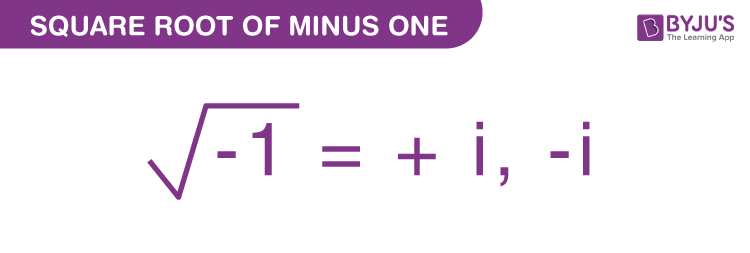In Mathematics, finding the square root of a number and squaring a number are inverse operations. In this article, we are going to discuss how to find the square root of minus one (i.e., square root of a negative number), along with many examples in detail. As we know, the square root of a number is a value which when multiplied by itself two times, results in the original number.
What is the Square Root of Minus One?

The square root of minus one is an imaginary number. Generally, the square root of all positive numbers is a real number, whereas the square root of all negative numbers is an imaginary number. Each and every positive real number should have a square root. The square root of 9 contains two roots, such as +3 and -3, while the square root of minus one also contains two roots, such as “i” and “-i”, where “i” represents the imaginary number.
How to Find the Value of the Square Root of Minus One?
To find the square root of a negative one, we have to look beyond the real numbers. We know that complex numbers are considered to be an extension of the real numbers from line to plane, which involves an important mathematical concept called “Imaginary Numbers”. Here, the term “imaginary” is employed, because none of the real numbers contain negative squares.
One such important property of imaginary numbers is:
i2 = -1 …(1)
(i.e., Squaring the imaginary number, results in the value -1).
Using this condition, we can derive the value of the square root of minus one.
Taking the square root on both sides of the equation (1), we get
√i2 = √-1
Cancelling square and square root in the LHS of the above equation,
√-1 = i
Hence, the square root of minus one √-1, is i, which is the principal square root of minus one.
Hence, the other square root of minus one is -i.
How to Find the Square Root of Negative Numbers?
Thus, the general form to find the square root of negative numbers is given as follows:
√(-x) = √[(-1).(x)]
Now, the above expression can be written as follows:
√(-x) = √-1. √x.
Since square root of minus is i, we can write;
√(-x) = i√x.
Square Root of Minus One Examples
Go through the problems given below to find the square root of negative numbers.
Example 1:
Find the square root of -25.
Solution:
Given: √-25.
The value of square root of -25 is calculated as follows:
√-25 = √[(-1).(25)]
√-25 = √-1. √25.
Now, substitute √-1 = i and √25, we get
√-25 = i (5)
Hence, the square of -25 is 5i.
Example 2:
Find the square root of -81.
Solution:
Given: √-81
√-81 = √[(-1).(81)]
√-81 = √-1. √81.
Substituting √81 = 9 and √-1 = i, we get
√-81 = (i) 9
√-81 = 9i
Therefore, the square root of -81 is 9i.
Example 3:
What is the value of the square root of -3?
Solution:
Given: √-3.
√-3 = √[(-1).(3)]
√-3 = √-1. √3
As we know, the square root of 3 is 1.732, and the square root of -1 is i.
Hence, √-3 = 1.732i.
Therefore, the square root of -3 is 1.732i.
| Also, read: |
Practice Questions
Practice the following problems:
- Find the square root of -7.
- What is the square root of -36?
- Determine the value of square root of -121.
Visit BYJU’S – The Learning App and download the app to learn all Maths concepts quickly by exploring more videos.
Frequently Asked Questions on Square Root of Minus One
Is the square root of minus one a real number?
No, the square root of minus one is not a real number.
What is the value of the square root of minus one?
The square root of minus one is “i” and “-i”, which is an imaginary number.
What is the square root of -4?
The square root of -4 is 2i.
What is the square root of a negative one?
The square root of a negative one is an imaginary number.
Is the square root of the negative one a rational number?
No, the square root of a negative one is not a rational number. As the square root of minus one is not a real number, it should not be a rational number.
Comments